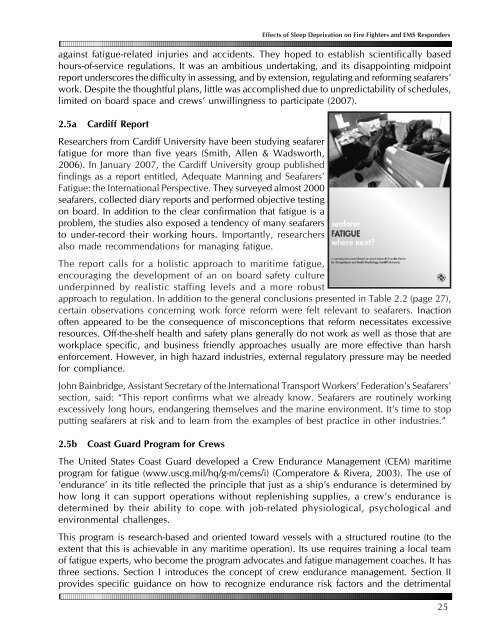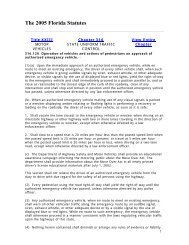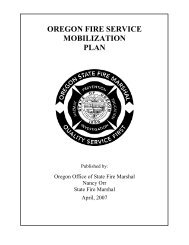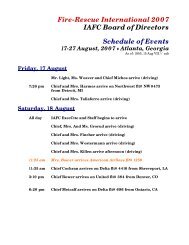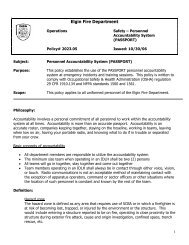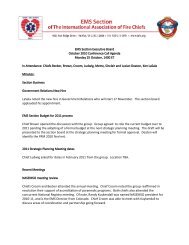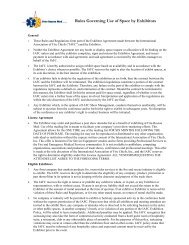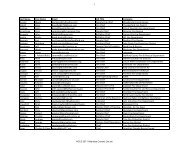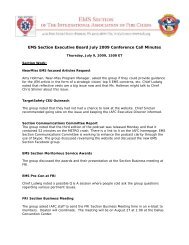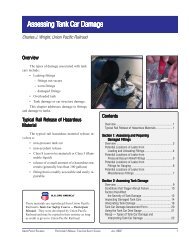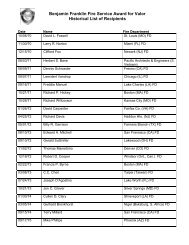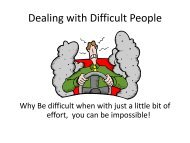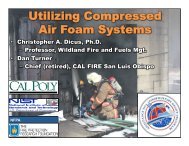Effects of Sleep Deprivation on Fire Fighters and EMS ... - NAEMT
Effects of Sleep Deprivation on Fire Fighters and EMS ... - NAEMT
Effects of Sleep Deprivation on Fire Fighters and EMS ... - NAEMT
Create successful ePaper yourself
Turn your PDF publications into a flip-book with our unique Google optimized e-Paper software.
<str<strong>on</strong>g>Effects</str<strong>on</strong>g> <str<strong>on</strong>g>of</str<strong>on</strong>g> <str<strong>on</strong>g>Sleep</str<strong>on</strong>g> <str<strong>on</strong>g>Deprivati<strong>on</strong></str<strong>on</strong>g> <strong>on</strong> <strong>Fire</strong> <strong>Fighters</strong> <strong>and</strong> <strong>EMS</strong> Resp<strong>on</strong>ders<br />
against fatigue-related injuries <strong>and</strong> accidents. They hoped to establish scientifically based<br />
hours-<str<strong>on</strong>g>of</str<strong>on</strong>g>-service regulati<strong>on</strong>s. It was an ambitious undertaking, <strong>and</strong> its disappointing midpoint<br />
report underscores the difficulty in assessing, <strong>and</strong> by extensi<strong>on</strong>, regulating <strong>and</strong> reforming seafarers’<br />
work. Despite the thoughtful plans, little was accomplished due to unpredictability <str<strong>on</strong>g>of</str<strong>on</strong>g> schedules,<br />
limited <strong>on</strong> board space <strong>and</strong> crews’ unwillingness to participate (2007).<br />
2.5a Cardiff Report<br />
Researchers from Cardiff University have been studying seafarer<br />
fatigue for more than five years (Smith, Allen & Wadsworth,<br />
2006). In January 2007, the Cardiff University group published<br />
findings as a report entitled, Adequate Manning <strong>and</strong> Seafarers’<br />
Fatigue: the Internati<strong>on</strong>al Perspective. They surveyed almost 2000<br />
seafarers, collected diary reports <strong>and</strong> performed objective testing<br />
<strong>on</strong> board. In additi<strong>on</strong> to the clear c<strong>on</strong>firmati<strong>on</strong> that fatigue is a<br />
problem, the studies also exposed a tendency <str<strong>on</strong>g>of</str<strong>on</strong>g> many seafarers<br />
to under-record their working hours. Importantly, researchers<br />
also made recommendati<strong>on</strong>s for managing fatigue.<br />
The report calls for a holistic approach to maritime fatigue,<br />
encouraging the development <str<strong>on</strong>g>of</str<strong>on</strong>g> an <strong>on</strong> board safety culture<br />
underpinned by realistic staffing levels <strong>and</strong> a more robust<br />
approach to regulati<strong>on</strong>. In additi<strong>on</strong> to the general c<strong>on</strong>clusi<strong>on</strong>s presented in Table 2.2 (page 27),<br />
certain observati<strong>on</strong>s c<strong>on</strong>cerning work force reform were felt relevant to seafarers. Inacti<strong>on</strong><br />
<str<strong>on</strong>g>of</str<strong>on</strong>g>ten appeared to be the c<strong>on</strong>sequence <str<strong>on</strong>g>of</str<strong>on</strong>g> misc<strong>on</strong>cepti<strong>on</strong>s that reform necessitates excessive<br />
resources. Off-the-shelf health <strong>and</strong> safety plans generally do not work as well as those that are<br />
workplace specific, <strong>and</strong> business friendly approaches usually are more effective than harsh<br />
enforcement. However, in high hazard industries, external regulatory pressure may be needed<br />
for compliance.<br />
John Bainbridge, Assistant Secretary <str<strong>on</strong>g>of</str<strong>on</strong>g> the Internati<strong>on</strong>al Transport Workers’ Federati<strong>on</strong>’s Seafarers’<br />
secti<strong>on</strong>, said: “This report c<strong>on</strong>firms what we already know. Seafarers are routinely working<br />
excessively l<strong>on</strong>g hours, endangering themselves <strong>and</strong> the marine envir<strong>on</strong>ment. It’s time to stop<br />
putting seafarers at risk <strong>and</strong> to learn from the examples <str<strong>on</strong>g>of</str<strong>on</strong>g> best practice in other industries.”<br />
2.5b Coast Guard Program for Crews<br />
The United States Coast Guard developed a Crew Endurance Management (CEM) maritime<br />
program for fatigue (www.uscg.mil/hq/g-m/cems/i) (Comperatore & Rivera, 2003). The use <str<strong>on</strong>g>of</str<strong>on</strong>g><br />
‘endurance’ in its title reflected the principle that just as a ship’s endurance is determined by<br />
how l<strong>on</strong>g it can support operati<strong>on</strong>s without replenishing supplies, a crew’s endurance is<br />
determined by their ability to cope with job-related physiological, psychological <strong>and</strong><br />
envir<strong>on</strong>mental challenges.<br />
This program is research-based <strong>and</strong> oriented toward vessels with a structured routine (to the<br />
extent that this is achievable in any maritime operati<strong>on</strong>). Its use requires training a local team<br />
<str<strong>on</strong>g>of</str<strong>on</strong>g> fatigue experts, who become the program advocates <strong>and</strong> fatigue management coaches. It has<br />
three secti<strong>on</strong>s. Secti<strong>on</strong> I introduces the c<strong>on</strong>cept <str<strong>on</strong>g>of</str<strong>on</strong>g> crew endurance management. Secti<strong>on</strong> II<br />
provides specific guidance <strong>on</strong> how to recognize endurance risk factors <strong>and</strong> the detrimental<br />
25


